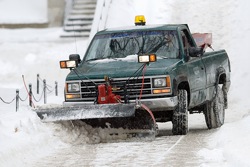The frosty side of winter arrives, and campus employees respond
Old Man Winter decided to mostly sleep through the first semester.
But when the snow finally did hit – more than 5 inches blanketed the campus last Thursday and more snow arrived on Tuesday, Jan. 17 – the UW–Madison Grounds Department crews didn’t hit the snooze button. Workers were ready to clear pathways for UW staff and faculty when the first flakes began to fall.
Work continued throughout the day and into the night as drifting snow continued to pile up. Kris Ackerbauer, Physical Plant assistant director, said crews were given a few hours off late Thursday and came back at 2 a.m. Friday to clean up streets and sidewalks before most UW employees reported for work. And the Tuesday snow had employees back on the streets and sidewalks.
It’s a schedule familiar to the grounds department. When 18 inches of snow fell in less than 24 hours last February, the UW–Madison campus shut down.
“Everybody was told to stay home. But we came in,” says Ellen Agnew, grounds supervisor at the UW Grounds Department.
The grounds department began winterizing equipment back in October. The goal was to be ready by Nov. 1 in case of early season snowstorms. When heavy snows didn’t materialize, Ackerbauer said grounds workers were able to work ahead on tree trimming projects. Grounds has 28 full-time employees and can bring in up to 10 LTEs to help in shoveling.
Grounds department employees updated maps to include new areas that need to be serviced, tuned up equipment and converted vehicles from warm to cold weather use to get ready for that first snow.
The campus includes 50 miles of sidewalks and 12 miles of road. Employees also help clear 87 city and campus bus stops. Campus custodial staff take care of the shoveling of steps and entryways near buildings.
An array of equipment is used to attack the snow. The department has 11 pickups outfitted with plows to clear parking lots, four more pickups rigged with plows and sanders for sidewalks and parking ramps, three Bobcats to remove snow from loading docks, two Bobcats to clear bus stops, and six tractors equipped with rotary brooms to blast the snow off sidewalks when the accumulation is three inches or less.
In addition, three dump trucks are used for sanding on streets and large parking lots around campus, and the department also has snowblowers at its disposal. One hundred and eighty tons of salt is kept on campus, with another 300 tons stored at the West Madison Agricultural Research Station on Mineral Point Road just in case.
The university also contracts with Daniels General Contractors in Madison for snow removal in large parking lots and ramps.
Grounds workers monitor radar from the National Weather Service for snowstorms.
Snow clearing usually begins at 1 or 2 in the morning, when streets and sidewalks are most likely to be empty.
Even during the most extreme storms, like last February, Agnew and the other supervisors try to keep any one of their crew from working more than a 16-hour shift. If a crewmember is too tired after a long shift, or if travel remains treacherous, it’s not unusual for workers to sack out on air mattresses right in the Grounds shop.
“There hasn’t been a winter that I haven’t slept here at least one night,” says Agnew, a UW–Madison horticulture grad who’s been with the department for eight years.
For problem areas on campus in need of plowing or shoveling attention, please contact UW Physical Plant (Grounds) at physical.plant.cars@fpm.wisc.edu or (608) 263-3333.
Campus officials will call a Snow Action Day when significant snowy weather is expected, to alert the campus community and better enable crews to remove snow. It is an advisory and a call to action and does not mean that classes have been canceled or the university has been closed. Those announcements will be made separately.
A Snow Action Day designation will be announced on the university’s home page and will include the following:
- People will be encouraged to leave their cars at home and ride the bus to campus.
- Moped and bicycle travel will be discouraged.
- New winter parking rules in specific parking lots and some university streets will take effect.
- The top level of parking ramps will be closed to allow snow clearance.
- Signs will be placed at the bus stop atop Bascom Hill and at the Memorial Union if buses cannot make the steep trip up Observatory Drive during storms, to better inform riders.
- Motorists will be urged to park in cleared areas of parking lots or in ramps, where possible.
“The main goal is safety,” Agnew says. “We want to make sure people can walk safely from building to building, and cars can get through campus.”




